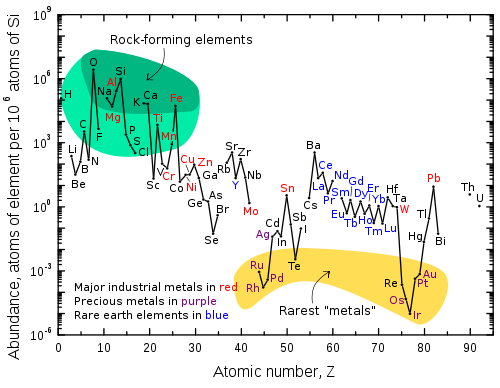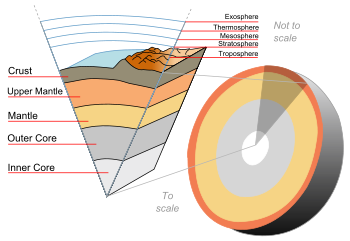- Crust (geology)
-

In geology, the crust is the outermost solid shell of a rocky planet or natural satellite, which is chemically distinct from the underlying mantle. The crusts of Earth, our Moon, Mercury, Venus, Mars, Io, and other planetary bodies have been generated largely by igneous processes, and these crusts are richer in incompatible elements than their respective mantles.
Contents
Earth's crust and Mantle
The crust of the Earth is composed of a great variety of igneous, metamorphic, and sedimentary rocks. The crust is underlain by the mantle. The upper part of the mantle is composed mostly of peridotite, a rock denser than rocks common in the overlying crust. The boundary between the crust and mantle is conventionally placed at the Mohorovičić discontinuity, a boundary defined by a contrast in seismic velocity. Earth's crust occupies less than 1% of Earth's volume.
The oceanic crust of the sheet is different from its continental crust. The oceanic crust is 5 km (3 mi) to 10 km (6 mi) thick[1] and is composed primarily of basalt, diabase, and gabbro. The continental crust is typically from 30 km (20 mi) to 50 km (30 mi) thick, and is mostly composed of slightly less dense rocks than those of the oceanic crust. Some of these less dense rocks, such as granite, are common in the continental crust but rare to absent in the oceanic crust. Both the continental and oceanic crust "float" on the mantle (see isostasy). Because the continental crust is thicker, it extends both above and below the oceanic crust, much like a large iceberg floating next to smaller one. (The slightly lighter density of felsic continental rock compared to basaltic ocean rock also contributes to the higher relative elevation of the top of the continental crust.) Because the top of the continental crust is above that of the oceanic, water runs off the continents and collects above the oceanic crust. The continental crust and the oceanic crust are sometimes called sial and sima respectively. Due to the change in velocity of seismic waves it is believed that on continents at a certain depth sial becomes close in its physical properties to sima and the dividing line is called The Conrad Discontinuity.
The temperature of the crust increases with depth, reaching values typically in the range from about 200°C (392°F) to 400°C (752°F) at the boundary with the underlying mantle. The crust and underlying relatively rigid uppermost mantle make up the lithosphere. Because of convection in the underlying plastic (although non-molten) upper mantle and asthenosphere, the lithosphere is broken into tectonic plates that move. The temperature increases by as much as 30°C (about 50°F) for every kilometer locally in the upper part of the crust, but the geothermal gradient is smaller in deeper crust.[2]
 Plates in the crust of the earth, according to the plate tectonics theory
Plates in the crust of the earth, according to the plate tectonics theory
Partly by analogy to what is known about our Moon, Earth is considered to have differentiated from an aggregate of planetesimals into its core, mantle and crust within about 100 million years of the formation of the planet, 4.6 billion years ago. The primordial crust was very thin, and was probably recycled by much more vigorous plate tectonics and destroyed by significant asteroid impacts, which were much more common in the early stages of the solar system.
The Earth has probably always had some form of basaltic crust, but the age of the oldest oceanic crust today is only about 200 million years. In contrast, the bulk of the continental crust is much older. The oldest continental crustal rocks on Earth have ages in the range from about 3.7 to 4.28 billion years [3][4] and have been found in the Narryer Gneiss Terrane in Western Australia, in the Acasta Gneiss in the Northwest Territories on the Canadian Shield, and on other cratonic regions such as those on the Fennoscandian Shield. A few zircons with ages as great as 4.3 billion years have been found in the Narryer Gneiss Terrane.
The average age of the current Earth's continental crust has been estimated to be about 2.0 billion years.[5] Most crustal rocks formed before 2.5 billion years ago are located in cratons. Such old continental crust and the underlying mantle asthenosphere are less dense than elsewhere in the earth and so are not readily destroyed by subduction. Formation of new continental crust is linked to periods of intense orogeny or mountain building; these periods coincide with the formation of the supercontinents such as Rodinia, Pangaea and Gondwana. The crust forms in part by aggregation of island arcs including granite and metamorphic fold belts, and it is preserved in part by depletion of the underlying mantle to form buoyant lithospheric mantle.
Composition of the continental crust
Main articles: Abundance of elements in Earth's crust and Goldschmidt classification Abundance (atom fraction) of the chemical elements in Earth's upper continental crust as a function of atomic number. The rarest elements in the crust (shown in yellow) are not the heaviest, but are rather the siderophile (iron-loving) elements in the Goldschmidt classification of elements. These have been depleted by being relocated deeper into the Earth's core. Their abundance in meteoroid materials is higher. Additionally, tellurium and selenium have been depleted from the crust due to formation of volatile hydrides.
Abundance (atom fraction) of the chemical elements in Earth's upper continental crust as a function of atomic number. The rarest elements in the crust (shown in yellow) are not the heaviest, but are rather the siderophile (iron-loving) elements in the Goldschmidt classification of elements. These have been depleted by being relocated deeper into the Earth's core. Their abundance in meteoroid materials is higher. Additionally, tellurium and selenium have been depleted from the crust due to formation of volatile hydrides.
This table shows the abundance of elements in Earth's crust. Numbers show percentage in mass. The continental crust has an average composition similar to that of the igneous rock, andesite. The composition tabulated below and the following discussion are based largely on the summary by Rudnick and Gao (2003).[6] Continental crust is enriched in incompatible elements compared to the basaltic ocean crust and much enriched compared to the underlying mantle. Although the continental crust comprises only about 0.6 weight percent of the silicate Earth, it contains 20% to 70% of the incompatible elements.
Oxide Percent SiO2 60.6 Al2O3 15.9 CaO 6.4 MgO 4.7 Na2O 3.1 Fe as FeO 6.7 K2O 1.8 TiO2 0.7 P2O5 0.1 All the other constituents except water occur only in very small quantities, and total less than 1%. Estimates of average density for the upper crust range between 2.69 g/cm3 and 2.74 g/cm3 and for lower crust between 3.0 g/cm3 and 3.25 g/cm3.[7]
A more detailed and comprehensive list of elemental composition for the upper crust is given in the main article abundance of elements in Earth's crust.
Moon's crust
Main article: Geology of the MoonA theoretical protoplanet named "Theia" is thought to have collided with the forming Earth, and part of the material ejected into space by the collision accreted to form the Moon. As the Moon formed, the outer part of it is thought to have been molten, a “lunar magma ocean.” Plagioclase feldspar crystallized in large amounts from this magma ocean and floated towards the surface. The cumulate rocks form much of the crust. The upper part of the crust probably averages about 88% plagioclase (near the lower limit of 90% defined for anorthosite): the lower part of the crust may contain a higher percent of ferromagnesian minerals such as the pyroxenes and olivine, but even that lower part probably averages about 78% plagioclase.[8] The underlying mantle is denser and is also olivine-rich.
The thickness of the crust ranges between about 20 and 120 km. Crust on the far side of the moon averages about 12 km thicker than that on the near side. Estimates of average thickness fall in the range from about 50 to 60 km. Most of this plagioclase-rich crust formed shortly after formation of the moon, between about 4.5 and 4.3 billion years ago. Perhaps 10% or less of the crust consists of igneous rock added after the formation of the initial plagioclase-rich material. The best-characterized and most voluminous of these later additions are the mare basalts formed between about 3.9 and 3.2 billion years ago. Minor volcanism continued after 3.2 billion years, perhaps as recently as 1 billion years ago. There is no evidence of crustal formation or deformation due to plate tectonics.
Study of the Moon has established that a crust can form on a rocky planetary body significantly smaller than Earth. Although the radius of the Moon is only about a quarter that of Earth, the lunar crust has a significantly greater average thickness. This thick crust formed almost immediately after formation of the Moon. Magmatism continued after the period of intense meteorite impacts ended about 3.9 billion years ago, but igneous rocks younger than 3.9 billion years make up only a minor part of the crust.[9]
See also
- Eduction
- Continental crust
- Oceanic crust
References
- ^ http://www.eoearth.org/article/Structure_of_the_Earth Structure of the Earth on Earth Online website |accessdate=2009-12-14
- ^ http://www.channel4.com/science/microsites/S/science/nature/journey.html Earth
- ^ "Team finds Earth's 'oldest rocks'". BBC News. 2008-09-26. http://news.bbc.co.uk/1/hi/sci/tech/7639024.stm. Retrieved 2010-03-27.
- ^ P. J. Patchett and S. D. Samson, 2003, Ages and Growth ot the Continental Crust from Radiogenic Isotopes. In The Crust (ed. R. L. Rudnick) volume 3, pages 321-348 of Treatise on Geochemistry (eds. H. D. Holland and K. K. Turekian), Elsevier-Pergamon, Oxford
- ^ A. I. S. Kemp and C. J. Hawkesworth, 2003, Granitic Perspectives on the Generation and Secular Evolution of the Contnental Crust. In The Crust (ed. R. L. Rudnick) volume 3, pages 349-410 of Treatise on Geochemistry (eds. H. D. Holland and K. K. Turekian), Elsevier-Pergamon, Oxford
- ^ R. L. Rudnick and S. Gao, 2003, Composition of the Continental Crust. In The Crust (ed. R. L. Rudnick) volume 3, pages 1-64 of Treatise on Geochemistry (eds. H. D. Holland and K. K. Turekian), Elsevier-Pergamon, Oxford
- ^ "Structure and composition of the Earth". Australian Museum Online. http://www.amonline.net.au/geoscience/earth/structure.htm. Retrieved 2007-09-14.
- ^ Wieczorek, M. A. & Zuber, M. T. (2001), "The composition and origin of the lunar crust: Constraints from central peaks and crustal thickness modeling", Geophysical Research Letters 28 (21): 4023–4026, Bibcode 2001GeoRL..28.4023W, doi:10.1029/2001GL012918.
- ^ Herald Hiesinger and James W. Head III, 2006, New views of Lunar geoscience: An introduction and overview. Reviews in Mineralogy & Geochemistry 60, p. 1-81.
 This article incorporates text from a publication now in the public domain: Chisholm, Hugh, ed (1911). Encyclopædia Britannica (11th ed.). Cambridge University Press.
This article incorporates text from a publication now in the public domain: Chisholm, Hugh, ed (1911). Encyclopædia Britannica (11th ed.). Cambridge University Press.
- Kent C. Condie, Origin of the Earth's Cruist, Palaeogeography, Palaeoclimatology, Palaeoecology (Global and Planetary Change Section), 75:57-81 1989, doi:10.1016/0031-0182(89)90184-3
External links
Shells Discontinuities Arguments Categories:
Wikimedia Foundation. 2010.

